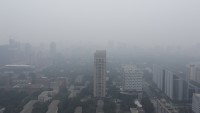Smog Yellow Alert: 13 Chinese Cites to Experience Heavy Smog Over The Weekend
| Kwao Peppeh | | Oct 17, 2015 08:09 AM EDT |
(Photo : REUTERS/Kim Kyung-Hoon) Joggers run in the hazy day near the National Stadium, also known as the ''Bird's Nest', in Beijing
China's struggle with air pollution, which often climbs to hazardous levels, continues. The weather observatory has issued a yellow alert for smog expected to shroud about 13 Chinese cites.
The National Meteorological Center (NMC) on Friday announced that heavy smog, which has already covered parts of eastern China, will continue through the weekend.
Like Us on Facebook
Several provinces are expected to experience the smog. However, officials say Shandong to be the worst affected. Beijing, Tianjin and parts of Hebei will also see smoggy conditions.
Officials have cautioned people living in the aforementioned cities to be careful. The elderly, children and people with respiratory diseases have been advised to stay indoors.
Authorities in Beijing and other cities have instituted stringent policies to control emissions and ensure cleaner air. However, heavy smog, little visibility and people wearing face masks continues to be common in several Chinese cities.
The hazards of air pollution are severe. According to a U.S. study, it contributes to the deaths of 1.6 million Chinese people yearly. In 2012, smoggy conditions led to the deaths of about 7 million people - 40 percent of the deceased lived around China's environs.
Smog experienced in China has frequently exceeded the World Health Organization (WHO) recommended maximum levels. PM 2.5, inhalable particles of dust, smoke, dirt and other substances have been the number one cause of death.
These tiny particles originate from either emission from chemical or industrial plants. They could also come from car emissions. Once in the human lungs, these particles penetrate the blood stream, causing heart attacks and other illnesses.
The WHO's recommended maximum level of PM2.5 is 25 micrograms per cubic meter. In January, the amount of PM2.5 in the air in China reached 568 micrograms per cubic meter.
By 2017, Beijing plans to reduce the density of hazardous inhalable particles in major cities by 10 percent. This year, the government announced a ban on some industrial plants.
Experts say the recent wave of smog is likely being caused by the traditional practice of farmers burning straw during their harvest in this month.
TagsChina Smog Yellow Alert, China Air Pollution, China PM2.5 air pollution
©2015 Chinatopix All rights reserved. Do not reproduce without permission
EDITOR'S PICKS
-

Did the Trump administration just announce plans for a trade war with ‘hostile’ China and Russia?
-

US Senate passes Taiwan travel bill slammed by China
-

As Yan Sihong’s family grieves, here are other Chinese students who went missing abroad. Some have never been found
-

Beijing blasts Western critics who ‘smear China’ with the term sharp power
-

China Envoy Seeks to Defuse Tensions With U.S. as a Trade War Brews
-

Singapore's Deputy PM Provides Bitcoin Vote of Confidence Amid China's Blanket Bans
-

China warns investors over risks in overseas virtual currency trading
-

Chinese government most trustworthy: survey
-

Kashima Antlers On Course For Back-To-Back Titles
MOST POPULAR
LATEST NEWS
Zhou Yongkang: China's Former Security Chief Sentenced to Life in Prison

China's former Chief of the Ministry of Public Security, Zhou Yongkang, has been given a life sentence after he was found guilty of abusing his office, bribery and deliberately ... Full Article
TRENDING STORY

China Pork Prices Expected to Stabilize As The Supplies Recover

Elephone P9000 Smartphone is now on Sale on Amazon India

There's a Big Chance Cliffhangers Won't Still Be Resolved When Grey's Anatomy Season 13 Returns

Supreme Court Ruled on Samsung vs Apple Dispute for Patent Infringement

Microsoft Surface Pro 5 Rumors and Release Date: What is the Latest?













